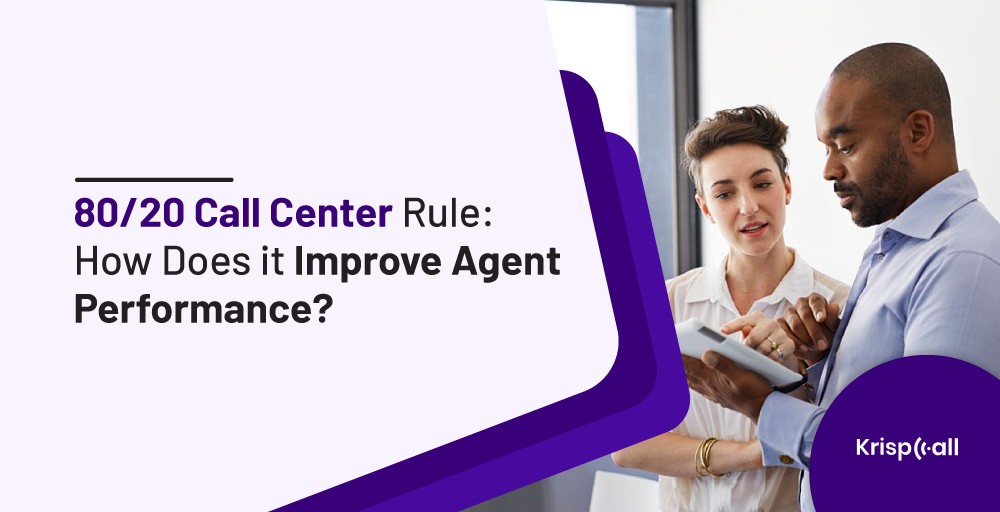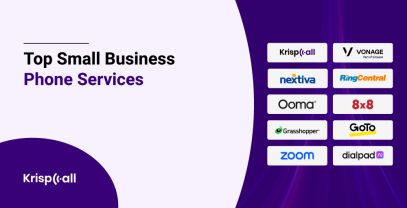Every call center service level has a call center rule which defines the percentage of calls being answered in a specified time.
Rule or protocol is the primary and important specification for service level or SL which can help to trace a call center’s performance.
Most call center businesses take service levels like a target that is estimated in 80/20 or 90/60 or any similar value, a combination of two figures.
When a call center business obtains a service level target of 80-20 call center rule, this means the agent of the business is expected to answer 80% of calls in less than or within 20 seconds.
80% of calls shown on your call center should have a queue time of fewer than 20 seconds.
So what’s more behind the 80-20 call center rule? And how to improve an agent’s performance using the 80/20 call center rule? Let’s find out in this article.
What is the Service level in a Call Center?
Service level in a call center can be defined as the rate of calls answered in a given period.
It simply represents a call center or calls center agent answering a customer’s calls within that specific time; the fewer time customers spend waiting in line and the better they’ll be with your company.
The service level is the percentage; the higher the percentage is, the better the level of service. It is the idea of service level as both a goal and a way to measure the performance parameter of the call center and its customer service team.
Get Phone Numbers for Your Virtual Call Center Easily.
Get super-affordable phone numbers from all over the world for your virtual call centers quickly and conveniently.
Select numbers :
How to Calculate Your Service Level?
The simplest way to calculate service level is to look at the number of calls the agents can answer within a certain time frame after the phone begins to ring.
This set time can be anywhere from seconds to a full minute. Divide that number by the number of calls coming in and multiply the result by 100.
The easiest way to calculate service level is to look at the number of calls the agents can answer within a certain time frame after the phone begins to ring. This set time can be anywhere from 10 seconds to a full minute.
Divide that number by the number of calls coming in and multiply the result by 100.
This will give you the service level percentage. Within that calculation, you can better understand the service level in customer service at the call center so you can gauge the quality of customer service callers receive.
Call Center Service Level Formula
Let’s say you aim to answer all calls within 20 seconds. On a given day, your call center dealt with 500 different calls, 425 of which were answered within 20 seconds.
425 calls answered within 20 seconds / 500 total calls = 0.85 X 100 = 85% service level
For that day, 85% of calls were answered within your chosen time frame, making that your service level percentage. That’s a good rate!
Why is Service Level Important in a Call Center?
The main goal of service level in the call centers arises the question of “how to maintain or enhance a specific service level in a contact center.”
The answer is to ensure that you have enough agents on hand at all times to handle incoming calls within the desired time limit. This can be difficult for business owners to handle their customer support calls.
You’re only allowed to answer a certain number of calls at any given moment, depending on the number of team members you have available.
Adding more team members to answer those calls can increase your service level but at a significant expense to your operating budget.
What is the 80-20 call Center Rule?
According to research “When call center business people were asked about their call center service level goal, many call center agents define the 80/20 rule as the primary-designed rule and goal to satisfy their client queries.”
However, an 80/20 call is the standard from a 30-year-old AT&T study applied to the call center service level, which should answer 80% of calls in 20 seconds or less.
It directs the agent to interact and respond quickly when they are on call with their client and answer their question in 20 seconds or less without missing or making them wait.
How to Maintain the 80/20 Call Center Rule?
The 80/20 rule establishes a concept of how quickly calls are answered. However, it only tells a call center how comfortable their clients are or how long they are willing to wait for an available agent. It also doesn’t take into account dropped calls.
With so much variance in the sector, you might be asking what other businesses have against this generally accepted industry-standard service level cgoal.
The truth behind maintaining the 80/20 call center rule you can use is that more and more call centers are taking longer to answer the phone, which indicates that they may be slowing down their average response time to target goals.
How does the 80/20 call center rule work in the fast-paced, time-critical world of call centers?
The call center world is evolving, just like everything else in today’s world of customer service. Part of that adjustment is to allow for longer, more extensive service calls to better serve customers.
Longer calls almost always result in a more positive experience for customers, as these interactions are often more individualized and focused on their genuine requirements rather than simply fulfilling target time goals.
How Can the 80/20 Rule Help with Your Longer Calls and Wait Times in Business?
The call abandonment rate is one of the most significant of these, which can occur when customers wait for an excessive amount of time. Longer hold times are an unavoidable consequence of this longer call structure.
This error shouldn’t be vital; after all, if you make too few calls, your business will suffer. However, the difference is likely to be significant enough that you can save money on labor as a result. If you adopt the 80/20 call center rule, take advantage of the savings.
Some cost reductions should be noted. Longer calls result in fewer calls to answer overall, resulting in fewer workers on the clock.
However, an equally simple alternative can save your clients from having to wait in line for long periods while simultaneously preventing you from having to overstaff your center to deal with the problem.
Provide your customer with the option of being contacted when an agent becomes available, and The callback can be one of the solutions for it.
This saves them time and money for your facility, and you’d be amazed how many clients appreciate having this alternative.
How Does the 80/20 Rule Improve Agent Performance?
You may have understood what the 80/20 rule call center is, how to maintain 80/20 rules for your business and how can 80/20 rule help with your longer calls and call management that can let you build a never-ending relationship between your agents and clients.
However, for continuing the never-ending relationship between your agents and client. You need to take care of your agent’s performance. Their performance matters a lot in your business’s happy customer experience and upbringing.
Here are some of the ideas why to apply the 80/20 call center rule to improve performance:
Fulfill customer expectations
Your customers’ needs have a significant impact on how long they are willing to wait in a call queue before being replied to.
For instance, A consumer who wants a quick solution to a basic query is more likely to hang up after a long wait than one who wants a more full and detailed answer to a more complex inquiry.
The 80/20 rule and better agent performance can effortlessly calculate service level goals. It will provide a sense of acceptable hold times that will fluctuate and hang on to the demands of your customers.
Better understanding
When consumers call your organization, their better understanding of expectations plays a big role in how long they’re willing to wait for their call to be answered.
Long hold times are expected in several businesses (e.g., airlines, credit card firms, etc.), and callers will normally wait longer to talk with a representative when calling these companies.
However, a better understanding of customers is also influenced by their early contacts with your organization. So, if their calls are usually answered fast, they will anticipate the same from your firm every time they contact you.
As a result, when deciding on an 80/20 call center standard, it’s crucial to consider service levels in your industry and the financial outcomes of failing to fulfill your customers’ expectations.
Know Customer Priorities
When a customer chooses your service level, it’s your critical role to consider their priorities. Some customers are ready to drop the quality of the conversation in the hunt for a faster response. Some people are willing to wait for a better agent to come along.
Customers who call you for information about a product they purchased, for example, are more likely to wait longer for a special deal than when they call for information about the product they purchased.
You can be stronger with the 80/20 rule and agent’s better performance of understanding your customer’s priorities.
Have patience
When setting service levels, it’s critical to consider being patient, whether from your end, your agent, or the client’s. To do so, you’ll need to figure out how long clients are willing to wait before their service quality suffers and they hang up.
It would help to consider whether these figures differ for high-value consumers versus low-value customers.
This is a tough field to estimate because it is affected by personal characteristics such as personality, mood, age, employment status, quantity of free time, and external influences such as time of day, company type, etc.
Create customer profiles and analyze demographic data to better understand your customers’ patience levels.
Have comfort with the client
Customer comfort should be one of the top concerns for agents’ performance for any incoming call center, and it should be considered while choosing a service level target.
It would be best if you researched how the client responds to longer wait times and how wait time can impact your customer’s happiness, satisfaction, loyalty, and after all, it’s for a business image.
Make your agent analysis with clients’ calls comfortably and account for their needs when accessing the service level.
Consider what the customer’s increased lifetime value will be if the service level is improved. You may ensure that your service level metric is linked to customer satisfaction by considering these variables while developing a service level objective.
Conclusion
80/20 call center rule: improving agent performance is an arbitrary target for call centers.
Customers may be willing to wait longer than 20 seconds to speak with someone if they are not forced to do so indefinitely.
They might even choose to locate the solution themselves through a better self-service option or, dare we say it, get a call back from a customer service professional at a later time.
High service levels at your contact center can be costly, and they may even lead to inefficiency if they don’t contribute to corporate strategy or customer satisfaction.
Before defining a service standard for your call center, think about what your customers truly want and how you can link it with your company goals. And be willing to make changes as new information becomes available.
Comment down and share your thought on the 80/20 call center rule and how it improve agent performance.





